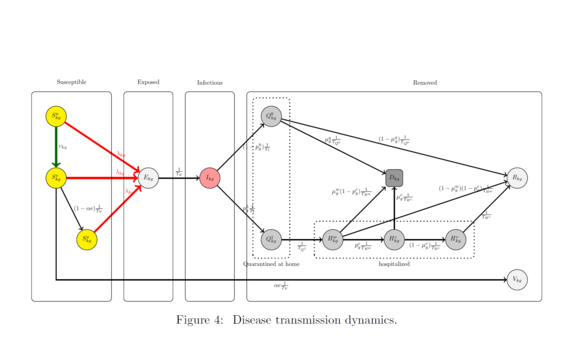Regional and adaptive targeting of vaccinations can be advantageous – Researchers examine effective vaccination strategies for coronavirus pandemic

Researchers at Aalto University have examined how different types of vaccine strategies affect the pandemic situation and how vaccine doses should be targeted regionally and according to age.
‘This is the first time during the coronavirus pandemic that the efficacy of the vaccine strategy has been studied while considering regional mobility. We modelled the age structure and contact between those people to be vaccinated in five catchment areas for highly specialised medical care, and movement between those areas,’ says Professor Tapio Ala-Nissilä, one of the leaders of the research project.
The researchers examined heuristic strategies, in which different amounts of emphasis can be given to target more vaccine doses to areas with a high incidence or where hospitals are struggling to cope. These strategies were compared to a mathematically optimised strategy with daily adjustment to targeting areas and age groups, allowing different age groups to be vaccinated simultaneously in order to reduce mortality as much as possible over the entire epidemic.
Parallel vaccination of several age groups could have additional benefits
The study is based on a new mathematical model that takes into account mobility across areas and differences in age groups. The model was fit to Finland's situation as closely as possible.
The researchers looked at data from a telecommunications operator's on how many people move between areas in a day, on average. In addition, public information was used on the numbers of people who have had a coronavirus infection and the number of those who have been vaccinated, as well as contacts between people in different age groups.
The researchers used the model to compare how different vaccine strategies affect the burden on healthcare and disease-induced mortality in different scenarios. They noticed that a suitable targeting of vaccinations regionally — as well as according to the disease situation — reduces the burden on health care while cutting disease-induced mortality more than the uniform distribution of vaccines according to population structure. The parallel vaccination of several age groups might also bring additional benefits. The protective effect of the chosen vaccination strategy is nevertheless strongly linked to the overall epidemic situation.
‘We did not find any single best vaccination strategy that would suit every situation. For example, how many restrictions are in force and the extent to which people avoid contact affects what strategy works best,’ says Assistant Professor Mikko Kivelä.
When an epidemic is waning, a chosen vaccination strategy does not have any major effect on the prevalence of the disease, or mortality, and using mathematically optimised vaccination strategies does not bring any significant additional protection.
When an epidemic is quickly spreading, targeting vaccinations regionally can help avert thousands of new infections and tens or hundreds of hospital visits, and save more human lives as compared to evenly distributing vaccines through the entire population. Using more complex mathematically optimised vaccination strategies might make it possible to achieve an even more significant further decline in hospital stays and deaths.
A slightly unexpected observation was that in some long-term and high infectivity scenarios, targeting vaccines regionally based on simple observables might lead to worse results than a model of even population-based distribution of the vaccines.
Professor Lasse Leskelä compares the situation to an extensive wildfire.
‘The fire brigade needs to decide how much firefighting equipment should be dedicated to fighting bigger flames and how much to leave for areas that are slowly smouldering. In a scenario of high infection levels with smouldering that is difficult to detect, leading to new flare-ups of the disease, excessive concentration of resources, i.e., vaccines, is not a good idea.’
The researchers emphasise that applying mathematical optimisation methods might help in finding balanced vaccination strategies, making it possible, in principle, to avert hundreds of hospitalisations and dozens of deaths. The challenge is that algorithmically optimised vaccination strategies might be logistically and administratively difficult to carry out.
‘Further research is needed to ascertain if it is possible to achieve an equivalent protection level of the population through simpler targeting rules,’ Professor Leskelä says.
Scientific community can offer information and models to support decision-making
The regional epidemic model developed in the study can be applied in other cases as well. It can be used, for example, to evaluate the impact of regional restrictions on movement on bringing the epidemic under control. In addition to the coronavirus pandemic, the results can also be applied to other cases of infectious disease.
‘We hope that this study will encourage decision-makers to engage members of the scientific community in societal decision-making more than has been done until now. We have research-based information and models on offer to support decision-making,’ Tapio Ala-Nissilä says.
The multidisciplinary working group had researchers from the fields of mathematics, information technology, and applied physics. The project was implemented with funding from the NordForsk programme of the Nordic Council of Ministers, which included collaborative partners from Sweden and Norway. The telecommunications operator Telia was the Finnish collaborative partner.
The study has been published on the open e-print archive arXiv.org
Further information:
Associate Professor Lasse Leskelä, Department of Mathematics and Systems Analysis
lasse.leskela@aalto.fi, tel. +358 40 537 5352
Assistant Professor Mikko Kivelä, Department of Computer Science
mikko.kivela@aalto.fi, tel. +358 50 382 4555
Professor Tapio Ala-Nissilä, Department of Applied Physics
tapio.ala-nissila@aalto.fi, tel. +358 40 541 2983
Read more news

The semiconductor sector jobs open in research groups
Semi-Summer 2026 programme will provide an opportunity to gain the skills needed in a growing and international semiconductor sector.
New cooperation agreement between the City of Helsinki and Aalto University to strengthen a sustainable, vibrant and knowledgeable city
The main themes of the cooperation are vitality, innovations and entrepreneurship, as well as research cooperation and knowledgeable labour, drawing heavily on the research and education expertise of the university.
Aalto Inventors innovation training coming for hydrogen, quantum and microelectronics researchers this spring
Connect with industry and academic thought-leaders and gain widely applicable skills in communication, intellectual property, and business.






